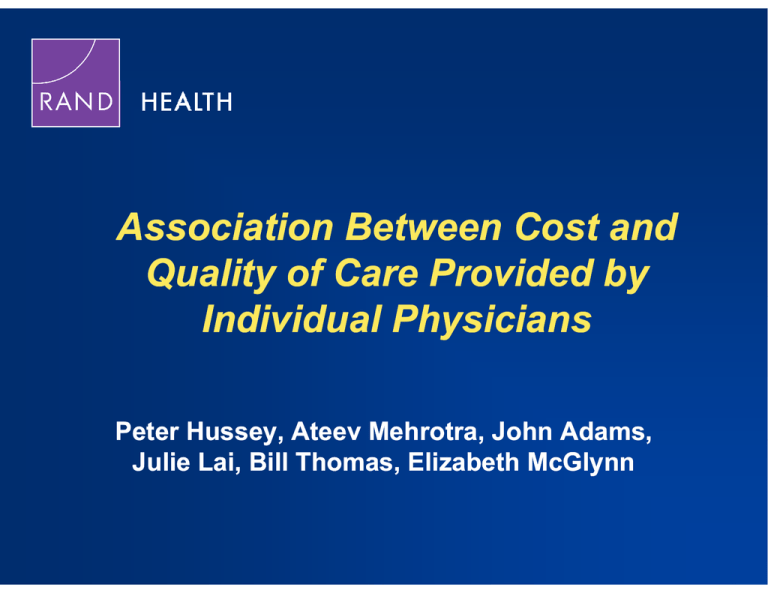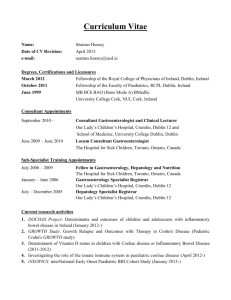Association Between Cost and
advertisement

Association Between Cost and Quality of Care Provided by Individual Physicians Peter Hussey, Ateev Mehrotra, John Adams, Julie Lai, Bill Thomas, Elizabeth McGlynn Study Sample 2004 2004--5 claims l i from f 4 Massachusetts M h tt health h lth plans l Combined database: • ~90% patients with commercial health insurance • 2.9 million enrollees Analyses focus on continuously enrolled adults between 18– 18–65 years old 6,139 MDs in 7 specialties Eligible for at least 10 unique quality indicators Excluded pediatric specialties and specialties with no direct patient care Excluded residents Hussey - 2 - 6/10 We Used an EpisodeEpisode-Based Cost M Measurement A Approach h Each patient’s claims divided into episodes of care Episode E i d off care is i all ll care provided id d over a period of time for a specific condition • e.g. Pneumonia – first through last claim for pneumonia pneumonia--related care Episodes defined using Symmetry ETG grouper Hussey - 3 - 6/10 We Calculated a Cost Score for Each Ph i i Physician Each episode assigned to physician with greatest fraction of costs Calculated for each episode Actual Costs & Expected Costs Expected Costs = average costs among episodes assigned to physicians of same specialty p y adjusted j for patient p co-morbidities coSum of Actual Costs Composite Cost Profile = --------------------------------Sum of Expected Costs Hussey - 4 - 6/10 Quality Measured Using ClaimsClaims-Based RAND QA T Tools l Used U d only l underuse d measures Subset of measures developed using RANDRAND-UCLA modified Delphi method and used in RAND national study of quality 117 unique q quality q y indicators covering g 20 acute and chronic conditions plus preventive care Performance scores were created by dividing all instances in which recommended care was delivered by the number of times patients were eligible for such care Adjusted for “degree of difficulty” by subtracting mean from each performance score Hussey - 5 - 6/10 Analyses Correlation C l ti between b t physician h i i costt and d quality lit scores Separate analysis by physician specialty type: Primary care (internal medicine, family medicine) Specialists (cardiology, endocrinology, nephrology, pulmonary p lmonar & critical care) Obstetrics/gynecology Separate analysis by type of care: acute, chronic, preventive Performed bivariate empirical Bayes shrinkage to adjust raw outcomes in proportion to the amount of information in each estimate Hussey - 6 - 6/10 No Significant CostCost-Quality Association in A Aggregate t A Analysis l i Hussey - 7 - 6/10 Small, Positive Correlation in Analysis by T Type off Care C All specialties Hussey - 8 - 6/10 Correlation Stronger for Specialists Primary Care Specialists Ob/Gyn Hussey - 9 - 6/10 Conclusions Cost C Costt-quality lit correlation l ti is i positive iti or nonnon-significant i ifi t Aggregate analyses may mask differences by type of care and specialty Cost Cost--quality relationship at the physician level may differ from area level Underscores the importance of accounting for quality in value value--based purchasing purchasing, bundled payment, payment tiered networks, and other policy interventions that create incentives to decrease costs Hussey - 10 - 6/10







